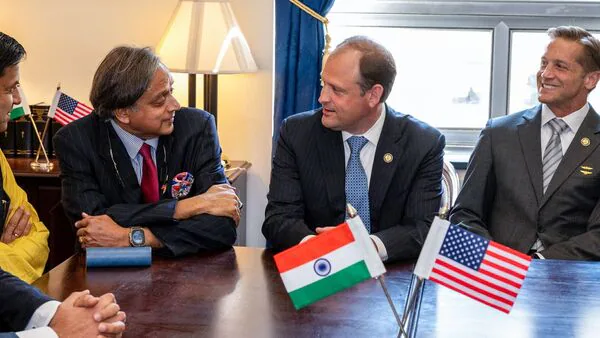Washington DC, June 5, 2025 – Congress leader Shashi Tharoor has described the name ‘Operation Sindoor’ as “brilliantly chosen,” during a speech in the United States capital. Speaking at a public event in Washington DC, Tharoor drew a poignant analogy between the colour of sindoor, a traditional vermilion powder worn by married Hindu women, and the colour of blood, highlighting the symbolic weight behind the operation’s name.
Tharoor explained that sindoor’s deep red hue is “not very different from the colour of blood,” underscoring the tragic reality of the violence that prompted the operation. Using the Hindi phrase “khoon ka badla khoon” (blood for blood), he emphasized the retaliation implied by Operation Sindoor — “sindoor ka badla khoon” — or blood as a response to the desecration and terror inflicted.
The operation was launched in the wake of a brutal terrorist attack that targeted cultural and religious symbols deeply revered by millions, including the traditional sindoor. Tharoor’s remarks shed light on the emotional and cultural resonance the name holds within the Indian context, suggesting that the operation is more than a strategic response; it is a statement of reclaiming dignity and honour.
Political analysts have noted that Tharoor’s articulation in an international forum serves not only to inform global audiences about the nuances of India’s internal security challenges but also to frame the operation in terms of cultural symbolism and national pride. By invoking traditional elements like sindoor, the government has effectively tapped into a powerful narrative that connects with the public on both emotional and patriotic levels.
The concept of Operation Sindoor was met with mixed reactions domestically, with supporters praising the government for taking a firm stand against terrorism and critics urging caution about the implications of symbolic warfare. However, Tharoor’s framing in Washington DC appears to align with the prevailing view among proponents, who believe the operation sends a strong message to the perpetrators that attacks on cultural identity will be met with resolute force.
In conclusion, Shashi Tharoor’s comments on Operation Sindoor highlight the interplay between symbolism and strategy in India’s fight against terrorism. By linking sindoor—the emblem of marital fidelity and cultural heritage—with the blood spilled in violent acts, Tharoor effectively conveys the gravity of the situation and the determination behind the government’s response. As India continues to grapple with security threats, such culturally resonant narratives may play a crucial role in shaping public perception and international understanding.



